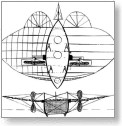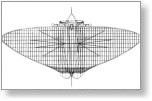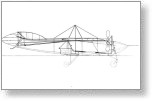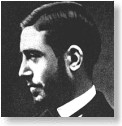| http://www.survol.cjb.net |
Pénaud Amphibian
 |
 |
| 1st drawing of the Pénaud-Gauchot project |
Last project (top view) |
 |
 |
| Last project (side view) |
Alphonse Pénaud |
| (click on the pictures to enlarge them in a new window) | |
Born in Paris
in 1850, Alphonse Pénaud was the first precursor to design
a stable aircraft, a small scale model named "Planaphore". This
small plane was shown to the members of the "Société
Française de Navigation Aérienne" in Paris (French
Aerial Navigation Society, one of the first aviation organization). The
aircraft could fly over 60 meters, it was fitted with a horizontal stabilizer
and powered by a rubber band engine, driving a two-blade propeller.
Penaud had solved the stability and center of gravity location issues,
and the characteristics of his airplane, truly advanced for the era, would
remain for a long time those of future airplanes.
Another project, developed in cooperation with Paul Gauchot and patented in 1876, was a flying wing : it was a two-seater amphibian monoplane, propelled by two variable pitch tractor type propellers ; the wing structure was planned to be built out of wood or metal, and the fuselage was waterproof. The machine was to be equipped with a retractable landing gear. The rudder and the were actuated by centralized controls. The controls gouvernes de direction et de profondeur (compensées) était centralisée. The list provided on the 1876 patent registration shows many inovative details : windshield, relative wind indicator, bank indicator, anemometer, electric control of the elevators, indicator of air pressure on the wings...
But Alphonse
Pénaud never founds the capitals to build his aircraft. On the
contrary, he was criticised, decried, misrepresented, and all sorts of
obstacles arose to prevent the testing of his project. Depression soon
began to ruin his health. He cut all ties with the Aeronautical Society,
and when he was refused further help from anyone he returned home and
committed suicide in October 1880, before he had reached 30 years of age.
The AV-221 prototype was christened "Alphonse Pénaud" by Charles Fauvel.